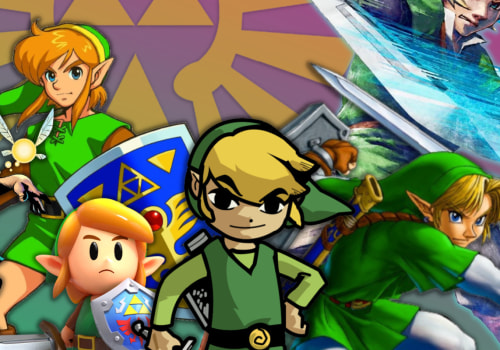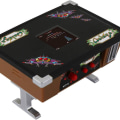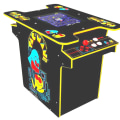Since its release in 1979, Intellivision has been a beloved classic among gamers. It was one of the first gaming consoles to offer a complete gaming experience, with its vibrant graphics and now iconic sounds. From its early days to its modern-day resurgence, Intellivision has provided countless hours of entertainment for generations of gamers. In this article, we'll take a look at the history of Intellivision, and how it has remained a staple in the gaming community for decades. The Intellivision was first released in 1979 and featured a number of advanced features for its time, including 16-color graphics, a 16-direction joystick controller, and four controller ports.
The console was well-received by critics, who praised its graphics and sound capabilities. It was particularly popular in the United States, where it sold over 3 million units. The Intellivision also featured a wide variety of games, both first-party titles developed by Mattel and third-party titles developed by other companies. Some of the most popular titles included Astrosmash, Las Vegas Poker & Blackjack, Sea Battle, and Utopia.
The system was also compatible with Atari 2600 games, allowing owners to play a wider variety of titles. In 1983, Mattel Electronics released an add-on peripheral for the Intellivision called the Entertainment Computer System (ECS). This add-on allowed users to use the Intellivision as a home computer, with basic programming and word processing capabilities. The ECS also allowed users to play more complex games, such as Dungeons & Dragons: Treasure of Tarmin. Despite its initial success, the Intellivision was unable to compete with the Nintendo Entertainment System (NES), which launched in 1985. The NES was more powerful than the Intellivision and featured popular franchises such as Super Mario Bros. and The Legend of Zelda.
As a result, sales of the Intellivision declined and Mattel discontinued the console in 1990. The Intellivision brand was revived in 2019 by Intellivision Entertainment LLC, a company founded by former Mattel Electronics employees Tommy Tallarico and Stephen Roney. The new console, called the Amico, features a number of classic Intellivision titles as well as new titles exclusive to the system. The Intellivision has had an enduring legacy in the gaming industry. Its advanced features for its time paved the way for future consoles and it remains a popular choice for retro gamers.
Decline and Revival
The Intellivision was a major success in the early days of the home gaming industry, but its popularity eventually waned. By the mid-1980s, the Intellivision had been largely outpaced by more advanced systems such as the Nintendo Entertainment System.Mattel Electronics discontinued the Intellivision in 1990 and sold off its assets. In 2019, however, the Intellivision was revived. Intellivision Entertainment, a company founded by former Mattel Electronics executives, released a new version of the console featuring modern graphics and support for classic Intellivision games. The new console was a success and continues to be popular among nostalgia-seekers and classic gaming enthusiasts.
Launch and Success
When the Intellivision first released in 1979, it was met with immediate success. It was the first widely-available home video game console, and it competed directly with the popular Atari 2600.The Intellivision offered more sophisticated graphics than the Atari and featured more advanced game controllers. Additionally, Mattel Electronics used innovative marketing tactics to promote the console and its games. The Intellivision was also popular for its library of exclusive titles. This included classic sports games such as Major League Baseball and NFL Football, as well as popular arcade-style games like Space Battle and Astronomy.
Mattel Electronics also released a series of educational titles aimed at children, such as Math Fun and Word Fun. The success of the Intellivision was short-lived, however. By the mid-1980s, the console had been largely supplanted by newer systems such as the Nintendo Entertainment System and the Sega Master System. Nonetheless, the Intellivision still holds a place in gaming history as one of the earliest home gaming consoles.
Entertainment Computer System
The Entertainment Computer System (ECS) was an add-on for the Intellivision console released in 1983. It expanded the capabilities of the Intellivision by adding support for more complex graphics and sound, as well as the ability to save game progress.The ECS also included a keyboard and a voice synthesis module to enable the console to be used for educational purposes. The ECS was a major upgrade to the Intellivision and allowed it to compete more directly with home computers of the time. It allowed for more intricate graphics, better sound, and more sophisticated programming. This enabled games on the Intellivision to become more complex and immersive than ever before.
Games such as Advanced Dungeons & Dragons and B-17 Bomber took advantage of the ECS’s features, allowing gamers to experience games that were previously only possible on a home computer. The Intellivision’s ECS was a revolutionary piece of technology that allowed gamers to experience gaming on a level previously only possible on home computers. Its impact was felt in the gaming industry for years to come, and its legacy continues today in modern gaming systems.
Legacy
The Intellivision has been an icon in the gaming industry since its release in 1979, and its legacy has withstood the test of time. Its unique controller design and library of games set it apart from other consoles at the time, and it has since become a classic example of early console gaming. The Intellivision's library of games included titles like Major League Baseball, NFL Football, Las Vegas Poker & Blackjack, Space Battle, and more.These titles provided hours of entertainment for its players and helped shape the gaming industry as a whole. The console also featured a unique controller design which was unlike any other at the time. Its circular disc-like design was ergonomic and comfortable to use, and its three action buttons allowed for more complex gameplay than was possible on other consoles. The Intellivision also featured online play through Mattel's PlayCable service, allowing gamers to compete with their friends from all around the world.
This was a revolutionary feature for its time, and helped pave the way for modern online gaming. Finally, the Intellivision's legacy is evidenced by its continued popularity among collectors and retro gamers. Despite being over 40 years old, the console still has a thriving community of collectors and fans who are passionate about preserving its history and keeping it alive. The Intellivision's lasting legacy in the gaming industry is undeniable.
Its unique design, library of games, and innovative features set it apart from other consoles at the time and helped shape the future of gaming as we know it today. The Intellivision is an iconic part of gaming history. Its launch in 1979 marked the beginning of the modern home console era, and its advanced features for its time paved the way for future consoles. Despite its decline in the 1980s, its revival in 2019 ensures that its legacy will continue for years to come. The Intellivision Entertainment Computer System helped the console stand out from its competition, and the development of its games library ensured that it had a lasting impact on the gaming industry. Its legacy is evident in modern consoles, with many drawing inspiration from the Intellivision's features and game library.













